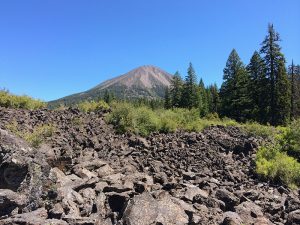
In 1980, an eruption of Mount St. Helens shook the Pacific Northwest in one of the most spectacular displays of volcanism in United States history.
Despite being one of the most well known volcanoes in the lower 48 states, Mount St. Helens is actually part of a chain of volcanoes that dot the west coast, from northern California through the southern coast of Canada. It’s a region called the Cascade Arc, and researchers in New Mexico State University’s Department of Geological Sciences have received a three-year grant from the National Science Foundation to investigate it.
Specifically, the team is analyzing the chemical composition of erupted lavas from several sites along the southern Cascades, from northern California to central Oregon, in an effort to better understand the origins of the magma, or molten rock, gathering beneath the volcanoes.
“The idea is that we can use what has erupted at the surface to get back to what’s happening at great depth,” said Emily Johnson, principal investigator on this project, and assistant professor of volcanology and igneous petrology in NMSU’s College of Arts and Sciences.
So what exactly is happening miles beneath this volcanic arc?
“This part of North America is right along a plate boundary,” Johnson said. “Earth’s surface is made up of different plates that can either separate, come together or slide past one another. In the case of the Cascades, we have an oceanic plate that’s colliding with the North American, continental, plate.”
When these plates collide, Johnson explained, the dense oceanic plate sinks beneath North America in a process called subduction. As the slab sinks, pressure and temperature increase and fluids are released from the slab, causing the mantle underneath the crust to melt and rise to the surface, forming a volcano.
With the southern Cascades being a relatively understudied portion of the arc, this research will help determine the origins of these magmas, and when volcanoes like Oregon’s Mount McLoughlin, and some smaller cinder cones in California, last erupted. This will offer indications as to when and how they may erupt in the future.
“It’s really interesting to look at the magmas that are erupted and how variable they can be over very short spatial scales,” Johnson said. “You think volcanoes that erupt within several kilometers of one another would perhaps be related at depth to some larger magmatic system. Then you analyze the composition and you realize these are completely unrelated magma batches that erupted very close to one another.”
One likely cause of this variation is the extra material being dragged down with the oceanic plate, including water, seafloor sediments, carbon dioxide and other trace elements. This material is added in variable amounts to the magmas, and directly impacts the nature of an eruption.
“Very gas-rich magmas tend to make very explosive eruptions, whereas gas-poor magmas have more docile, effusive eruptions,” Johnson said. “So our results will impact our understanding of the style of volcanism and how future volcanism may be.”
Johnson’s team is also analyzing seafloor sediments from a drill core obtained just offshore of the Cascades, allowing them to look directly at the descending material before it melts into magma.
While not a direct focus of Johnson’s research, her work in determining the amount of sediment being dragged with the sinking slab can impact how scientists study the potential for big earthquakes in the southern Cascades.
“You can think of sediment as being really water-rich, kind of slippery,” Johnson said. “That can actually lubricate that fault zone, and that will have implications for how those earthquakes may occur, how they would slip.”
While these west coast hazards may be a distant concern to New Mexico residents, Johnson explained that Las Cruces, too, has a volcanic past.
“The Organ Mountains are part of this very old caldera system that erupted about 35-36 million years ago,” she said. “The northern part of the Organ Mountains represents the magma that cooled inside the crust and never erupted. The southern part of the Organ Mountains is actually the volcanic rocks that erupted explosively.”
Johnson and her research group are studying the Organs in order to better understand what caused a sequence of large, explosive eruptions to occur in the region, and how the magma changed between those eruptions.
Video
Note: The above post is reprinted from materials provided by New Mexico State University (NMSU).









